Themed collection Most popular 2022 catalysis articles

Heterometallic bond activation enabled by unsymmetrical ligand scaffolds: bridging the opposites
Unsymmetrical ligand scaffolds bridging two or more different metals in a site-selective manner offer a convenient approach to utilize metal–metal cooperation for bond activation.
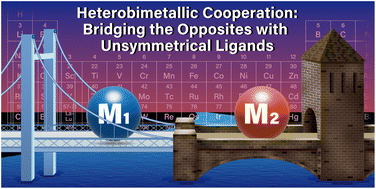
Chem. Sci., 2022,13, 14008-14031
https://doi.org/10.1039/D2SC04263K
Controlled monodefluorination and alkylation of C(sp3)–F bonds by lanthanide photocatalysts: importance of metal–ligand cooperativity
The controlled functionalization of a single fluorine in a CF3 group is difficult and rare. Photochemical C–F bond functionalization is achieved using catalysts made from a range of earth-abundant lanthanides by using a ligand that enables M–L cooperativity.

Chem. Sci., 2022,13, 14090-14100
https://doi.org/10.1039/D2SC04192H
Formation of exceptional monomeric YPhos–PdCl2 complexes with high activities in coupling reactions
Ylide-substituted phosphines form monomer, air-stable PdCl2 complexes which feature a unique bonding situation between the metal and the phosphine and ylide donor and exhibit high efficiencies as precatalysts in C–C and C–X cross-coupling reactions.

Chem. Sci., 2022,13, 13552-13562
https://doi.org/10.1039/D2SC04523K
Topology- and wavelength-governed CO2 reduction photocatalysis in molecular catalyst-metal–organic framework assemblies
Two MOF molecular catalyst hybrids with differing topologies show mass and light transport governed photocatalysis. MOF-specific, irradiation wavelength-dependent product control is unlocked by switching between two energy/electron transfer channels.
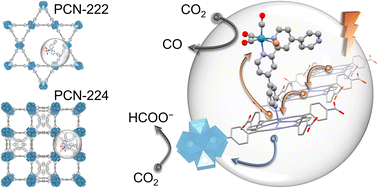
Chem. Sci., 2022,13, 12164-12174
https://doi.org/10.1039/D2SC03097G
Strategic design of Fe and N co-doped hierarchically porous carbon as superior ORR catalyst: from the perspective of nanoarchitectonics
This study elucidates the role of each class of nanopore by in-depth electrochemical analysis of three types of ZIF-8-derived carbons. Also, engineered co-doping of Fe and N is found essential to selectively form Fe–Nx sites in the carbon matrix.
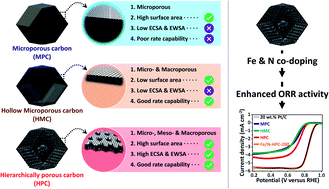
Chem. Sci., 2022,13, 10836-10845
https://doi.org/10.1039/D2SC02726G
Interfacial electric fields catalyze Ullmann coupling reactions on gold surfaces
The electric fields created at solid–liquid interfaces are important in heterogeneous catalysis.
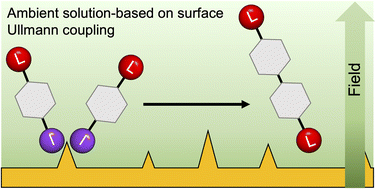
Chem. Sci., 2022,13, 10798-10805
https://doi.org/10.1039/D2SC03780G
Hemilabile MIC^N ligands allow oxidant-free Au(I)/Au(III) arylation-lactonization of γ-alkenoic acids
A novel hemilabile MIC^N ligand-based Au(I)-catalytic procedure for the synthesis of γ-substituted γ-butyrolactones through the arylation-lactonization reaction of the corresponding γ-alkenoic acid is presented.

Chem. Sci., 2022,13, 9351-9360
https://doi.org/10.1039/D2SC01966C
Photoredox catalysis via consecutive 2LMCT- and 3MLCT-excitation of an Fe(III/II)–N-heterocyclic carbene complex
An iron complex with N-heterocyclic carbene ligands engages in efficient photoredox catalysis via excited state electron transfer reactions of its Fe(II) and Fe(III) oxidation states.

Chem. Sci., 2022,13, 9165-9175
https://doi.org/10.1039/D2SC02122F
Nanoparticles and single atoms of cobalt synergistically enabled low-temperature reductive amination of carbonyl compounds
An earth-abundant Co-based catalyst, Co@C–N(800), could efficiently catalyze the reductive amination of carbonyl compounds into primary amines at 35 °C owing to the synergistic effect of Co nanoparticles and atomically dispersed Co–Nx sites.
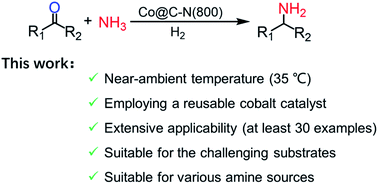
Chem. Sci., 2022,13, 9047-9055
https://doi.org/10.1039/D2SC01596J
Chain end-group selectivity using an organometallic Al(III)/K(I) ring-opening copolymerization catalyst delivers high molar mass, monodisperse polyesters
A heterodinuclear Al(III)/K(I) organometallic ring-opening copolymerization catalyst shows exceptional rates, end-group selectivity and good loading tolerance to deliver monodisperse polyesters with molar masses up to 91 kg mol−1.

Chem. Sci., 2022,13, 8543-8549
https://doi.org/10.1039/D2SC02752F
Carbocation catalysis in confined space: activation of trityl chloride inside the hexameric resorcinarene capsule
The hexameric resorcinarene capsule is able to promote carbocation catalysis inside its cavity.
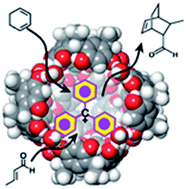
Chem. Sci., 2022,13, 8618-8625
https://doi.org/10.1039/D2SC02901D
Ni single atoms on carbon nitride for visible-light-promoted full heterogeneous dual catalysis
In this work, the first demonstration of heterogeneous photoredox C–N coupling is reported using Ni atoms on C3N4. Due to metal–support interactions, high activity and stability were observed during visible-light-driven C–N functionalization.

Chem. Sci., 2022,13, 8536-8542
https://doi.org/10.1039/D2SC02174A
Directed evolution of a cyclodipeptide synthase with new activities via label-free mass spectrometric screening
A robotic workflow for directed evolution of new enzymatic activities via high-throughput library creation and label-free MS screening.
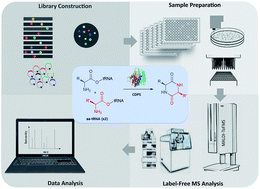
Chem. Sci., 2022,13, 7581-7586
https://doi.org/10.1039/D2SC01637K
Biocatalytic cascades and intercommunicated biocatalytic cascades in microcapsule systems
Dynamic dimerization of GOx-loaded microcapsules with β-gal//hemin/G-quadruplex-bridged T1/T2-loaded microcapsules guides the bi-directional intercommunication of the three catalysts cascade.

Chem. Sci., 2022,13, 7437-7448
https://doi.org/10.1039/D2SC01542K
Energy transfer (EnT) photocatalysis enabled by gold-N-heterocyclic carbene (NHC) complexes
We present the use of gold sensitizers [Au(SIPr)(Cbz)] (PhotAu 1) and [Au(IPr)(Cbz)] (PhotAu 2) as attractive alternatives to state-of-the-art iridium-based systems.
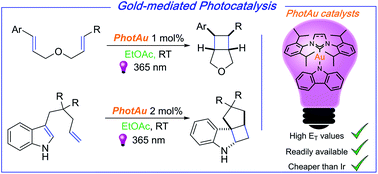
Chem. Sci., 2022,13, 6852-6857
https://doi.org/10.1039/D2SC00864E
Linker engineering in metal–organic frameworks for dark photocatalysis
A Ti-based MOF with long-lived Ti3+ can achieve dark photocatalysis. The different groups on the organic linker modulate electron storage ability and the lifetime of Ti3+, significantly regulating dark photocatalytic activity in H2 production.
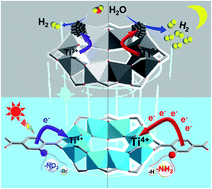
Chem. Sci., 2022,13, 6696-6703
https://doi.org/10.1039/D1SC06785K
A general electron donor–acceptor complex for photoactivation of arenes via thianthrenation
General photoactivation of EDA complexes between arylsulfonium salts and 1,4-diazabicyclo[2.2.2]octane was discovered. This practical mode enables the generation of aryl radicals for C–H functionalization of arenes.
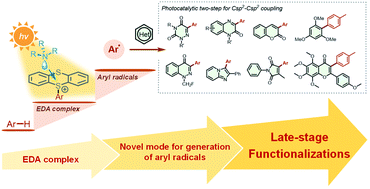
Chem. Sci., 2022,13, 5659-5666
https://doi.org/10.1039/D2SC01241C
Light-driven reduction of aromatic olefins in aqueous media catalysed by aminopyridine cobalt complexes
A dual catalytic system based on earth-abundant elements reduces aryl olefins to alkanes in aqueous media under visible light. Mechanistic studies allow for rational tunning of the system for the selective reduction of aryl olefins vs ketones and vice versa.
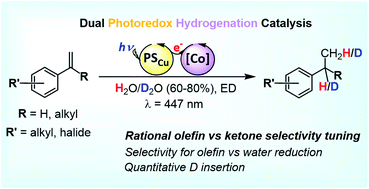
Chem. Sci., 2022,13, 4270-4282
https://doi.org/10.1039/D1SC06608K
Facile conversion of ammonia to a nitride in a rhenium system that cleaves dinitrogen
Rhenium–PNP complexes split N2 to nitrides, but the nitrides do not give ammonia. Here, the thermodynamics of the hypothetical N–H bond forming steps are evaluated through the reverse reaction, showing that the first H addition is the bottleneck.

Chem. Sci., 2022,13, 4010-4018
https://doi.org/10.1039/D1SC04503B
Chiral proline-substituted porous organic cages in asymmetric organocatalysis
Two calix[4]resorcinarene-based chiral POCs with different self-assembly forms were constructed. The difference in the spatial distribution of chiral organocatalytic sites leads to the two chiral POCs exhibiting distinct stereoselectivities.
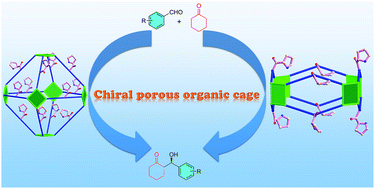
Chem. Sci., 2022,13, 3582-3588
https://doi.org/10.1039/D2SC00395C
Manipulation of charge carrier flow in Bi4NbO8Cl nanoplate photocatalyst with metal loading
An efficient spatial separation of photoexcited carriers is demonstrated in a layered-oxyhalide nanoplate by controlling the direction of carrier flows upon Rh cocatalyst loading, which leads to drastic photocatalytic H2 evolution activity.
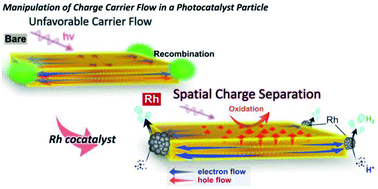
Chem. Sci., 2022,13, 3118-3128
https://doi.org/10.1039/D1SC06054F
Two-dimensional heterostructures built from ultrathin CeO2 nanosheet surface-coordinated and confined metal–organic frameworks with enhanced stability and catalytic performance
A synthetic strategy to prepare 2D heterostructures from ultrathin CeO2 surface-coordinated metal–organic framework was proposed, proving multiple effects of metal-coordinated interactions in 2D heterostructures.

Chem. Sci., 2022,13, 3035-3044
https://doi.org/10.1039/D2SC00308B
Propane dehydrogenation over extra-framework In(I) in chabazite zeolites
Indium-containing chabazite zeolites show better stability and C3H6 selectivity for propane dehydrogenation than In2O3, In/SiO2 and In/Al2O3. Extra-framework In+ is identified as the stable active site upon reduction of an impregnated sample.
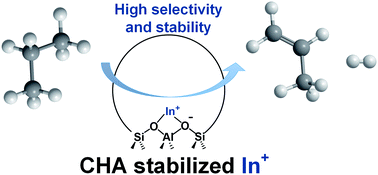
Chem. Sci., 2022,13, 2954-2964
https://doi.org/10.1039/D1SC05866E
Developing organoboranes as phase transfer catalysts for nucleophilic fluorination using CsF
Simple boranes with the optimal fluoride ion affinity are effective as catalysts for phase transfer nucleophilic fluorination with CsF.
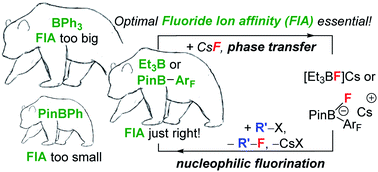
Chem. Sci., 2022,13, 2661-2668
https://doi.org/10.1039/D2SC00303A
A BINOL-phosphoric acid and metalloporphyrin derived chiral covalent organic framework for enantioselective α-benzylation of aldehydes
We report a new synthetic approach for the intermolecular α-alkylation of aldehydes with alkyl halides based on a BINOL-phosphate and Cu(II)-porphyrin derived multifunctional CCOF catalyst via visible-light induced photothermal conversion.
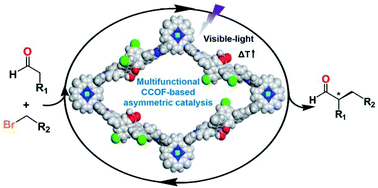
Chem. Sci., 2022,13, 1906-1911
https://doi.org/10.1039/D1SC06045G
EDOT-based conjugated polymers accessed via C–H direct arylation for efficient photocatalytic hydrogen production
The excellent reactivity toward C–H direct arylation, water wettability and O–C p–π conjugation endow EDOT to be an attractive electron donor unit for CP photocatalysts, yielding an unprecedented hydrogen evolution rate up to 0.95 mmol h−1/6 mg catalyst.
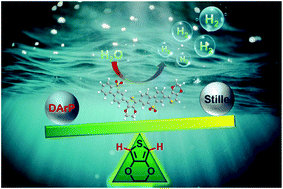
Chem. Sci., 2022,13, 1725-1733
https://doi.org/10.1039/D1SC05784G
2D-C3N4 encapsulated perovskite nanocrystals for efficient photo-assisted thermocatalytic CO2 reduction
A water-stable CsPbBr3 catalyst is designed using core–shell encapsulation of the perovskite nanoparticle by 2D-C3N4 for photo-assisted thermocatalytic CO2 reduction by H2O. The m-CN@CsPbBr3 heterojunction shows surprisingly high CO2-to-CO yield.
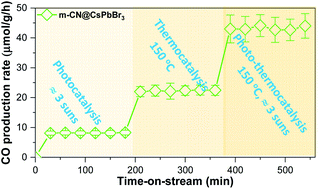
Chem. Sci., 2022,13, 1335-1341
https://doi.org/10.1039/D1SC06131C
About this collection
If a particular article has inspired you, do feel free to share on social media using the buttons on each article landing page and use our hashtag: #ChemSciMostPopular